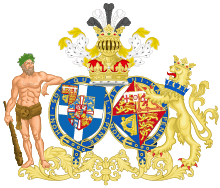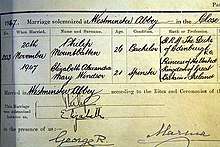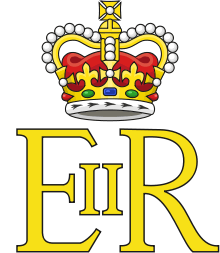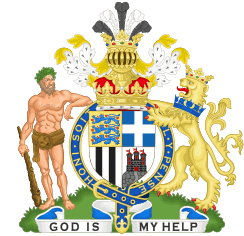Wedding of Princess Elizabeth and Philip Mountbatten
|
Princess Elizabeth and Philip Mountbatten on their wedding day. | |
| Date | 20 November 1947 |
|---|---|
| Venue | Westminster Abbey |
| Location | London, England |
| Participants |
The Princess Elizabeth Philip, Duke of Edinburgh |
The wedding of Princess Elizabeth and Philip Mountbatten took place on 20 November 1947 at Westminster Abbey in London. Philip had been made Duke of Edinburgh on the morning of the wedding.
Engagement
Elizabeth and Philip are second cousins once removed (by descent from Christian IX of Denmark and Louise of Hesse-Kassel) and third cousins (by descent from Queen Victoria and Prince Albert). Princess Elizabeth met Prince Philip of Greece and Denmark in 1934, at the wedding of Philip's cousin Princess Marina of Greece and Denmark to Prince George, Duke of Kent, paternal uncle of Elizabeth, and again in 1937.[1] After another meeting at the Royal Naval College in Dartmouth in July 1939, Elizabeth—though only 13 years old—fell in love with Philip and they began to exchange letters.[2] An entry in Chips Channon's diary made reference to the future marriage of Elizabeth and Philip as early as 1941, "He is to be our Prince Consort, and that is why he is serving in our Navy."[3] The couple became secretly engaged in 1946, when Philip asked King George VI for his daughter's hand in marriage. The King granted his request providing any formal engagement was delayed until Elizabeth's 21st birthday the following April.[4] Their engagement was officially announced on 9 July 1947.[5] Philip proposed to Elizabeth with a 3-carat round diamond ring consisting of "a center stone flanked by 10 smaller pave diamonds."[6] The diamonds were taken from a tiara that belonged to Philip's mother, Princess Andrew of Greece, and were also used to create a bracelet for Elizabeth.[7]
The King gave his formal consent to the marriage in his British Privy Council, in accordance with the Royal Marriages Act 1772. The same was done in Canada at a meeting of the King's Canadian Privy Council, with the Chief Justice, Thibaudeau Rinfret, standing in as deputy to the King's representative, the Governor General of Canada.[n 1][8]
Wedding


Venue
Princess Elizabeth and Prince Philip were married at 11:30 GMT on 20 November 1947 at Westminster Abbey.[9] Princess Elizabeth became the tenth member of the Royal Family to be married at the Abbey.[10]
Bridal party
Princess Elizabeth was attended by eight bridesmaids: The Princess Margaret (her younger sister), Princess Alexandra of Kent (her first cousin), Lady Caroline Montagu-Douglas-Scott (daughter of the Duke of Buccleuch), Lady Mary Cambridge (her second cousin), Lady Elizabeth Lambart (daughter of the Earl of Cavan), Pamela Mountbatten (Philip's first cousin), Margaret Elphinstone (her first cousin), and Diana Bowes-Lyon (her first cousin).[9] Her cousins Prince William of Gloucester and Prince Michael of Kent served as page boys.[9]
The best man was the Marquess of Milford Haven,[10] the groom's maternal first cousin. The Marquess was a grandson of Prince Louis of Battenberg and Princess Victoria of Hesse and by Rhine; and a great-great-grandson of Queen Victoria.
Wedding attire
On the morning of her wedding, as Princess Elizabeth was dressing at Buckingham Palace before leaving for Westminster Abbey, her tiara snapped. The court jeweller, who was standing by in case of emergency, was rushed to his work room by a police escort. Queen Elizabeth reassured her daughter that it would be fixed in time, and it was. For her wedding dress she still required ration coupons to buy the material for her gown, designed by Norman Hartnell.[11][12] The dress was a "a duchesse satin bridal gown with motifs of star lilies and orange blossoms."[12] Elizabeth did her own makeup for the wedding.[13]
Wedding service
The royal parties were brought in large carriage processions, the first with The Queen and Princess Margaret and later a procession with Queen Mary.[14] Philip left Kensington Palace with his best man, the Marquess of Milford Haven.[14] Princess Elizabeth arrived at the Abbey with her father, King George, in the Irish State Coach.[9]
The ceremony was officiated by the Archbishop of Canterbury, Geoffrey Fisher, and the Archbishop of York, Cyril Garbett. The ceremony was recorded and broadcast by BBC Radio to 200 million people around the world.[12][15]
Wedding ring
Like her mother, Princess Elizabeth's wedding band was made of Welsh gold.[16][17] The ring was made from a nugget of Welsh gold from the Clogau St David's mine, near Dolgellau;[10] this nugget had been given to the then Lady Elizabeth Bowes-Lyon, and used to make her wedding ring and subsequently the wedding rings of both of her daughters.[17] The same nugget was later used to create the wedding rings of Princess Anne and Lady Diana Spencer.[17]
Music
William Neil McKie, the Australian organist and Master of the Choristers at the abbey, was the director of music for the wedding, a role he again filled at Elizabeth's coronation in 1953.[18] McKie also wrote a motet for the occasion, "We wait for thy loving kindness, O God". Psalm 67, "God be merciful unto us and bless us", was sung to a setting by Sir Edward Cuthbert Bairstow. The anthem was "Blessed be the God and Father of our Lord Jesus Christ" by Samuel Sebastian Wesley; the hymns were "Praise, my soul, the king of heaven", and "The Lord's my Shepherd" to the Scottish tune "Crimond" attributed to Jessie Seymour Irvine, which was largely unknown in the Church of England at the time. A descant to "Crimond" had been taught to Princesses Elizabeth and Margaret by a lady-in-waiting, Lady Margaret Egerton; the music for the descant could not be found two days before the wedding, so the princesses and Lady Margaret sang it to Sir William McKie, who wrote it down in shorthand.[19] The service started with a specially composed fanfare by Arnold Bax and finished with Felix Mendelssohn's "Wedding March". The abbey choir was joined by the choirs of the Chapel Royal and St George's Chapel, Windsor.[20]
Title
Before the wedding, Philip renounced his Greek and Danish titles as required by the Act of Settlement, 1701, converted from Greek Orthodoxy to Anglicanism and adopted the style "Lieutenant Philip Mountbatten", taking the surname of his mother's British family.[21] The day before the wedding, King George bestowed the style "Royal Highness" and, on the morning of the wedding, 20 November 1947, he was made the Duke of Edinburgh, Earl of Merioneth, and Baron Greenwich of Greenwich in the County of London.[22] Consequently, being already a Knight of the Garter, between 19 and 20 November 1947 he bore the unusual style His Royal Highness Sir Philip Mountbatten and is so described in the Letters Patent of 20 November 1947.[22]
Upon their marriage, Elizabeth took the title of her husband and became Princess Elizabeth, Duchess of Edinburgh. They departed for their honeymoon at Broadlands in Hampshire, home of Philip's uncle, Earl Mountbatten.[23]
Family celebrations
After the ceremony, Elizabeth and Philip then proceeded to Buckingham Palace, where the couple waved to the crowds from the balcony.
Their wedding breakfast was held in the Ball-Supper Room of the Palace.[9][10] The menu included Filet de Sole Mountbatten, Perdreau en Casserole, and Bombe Glacee Princess Elizabeth.[10] Music was played by the string band of the Grenadier Guards.[10]
The official wedding cake was baked by London bakery McVitie & Price.[10][24] The cake was a fruitcake made of four tiers; it stood nine feet high,[10] and weighed about 500 lbs.[24] It was made with 80 oranges, 660 eggs, and over three gallons of Navy Rum. As World War II had ended a mere two years earlier and certain things were still [24] subject to rationing, some of the ingredients used to make the cake were shipped to Britain from around the world; this led to the cake being given the nicknamed "The 10,000 Mile Cake.[10][24] Decorations included the arms of both the bride's and the groom's families, as well as the bride and groom's individual monograms, and sugar-iced figures depicting regimental and naval badges, as well as the couple's favorite activities.[10] The couple cut the cake with the Duke of Edinburgh's Mountbatten sword, which had been a wedding gift from his father-in-law, the King.[10]
The couple received over 2,500 wedding presents from around the world and around 10,000 telegrams of congratulations.[9][12] The gifts were put on public display at St James's Palace and made available for public viewing.[10]
The day after the wedding the wedding bouquet was returned to Westminster Abbey and placed on the Tomb of the Unknown Warrior;[10] this tradition was initiated by the bride's mother, Queen Elizabeth, following her marriage to the bride's father, then the Duke of York. The bouquet was composed of white cattleya, odontoglossum, and cypripedium orchids and a sprig of myrtle from the Osborne Myrtle Bush, which had been planted at Osborne House by Queen Victoria in 1846.[25][26] The flowers in the bouquet were supplied by the Worshipful Company of Gardeners and were arranged by florist MH Longman.[10]
Guests
Bride's family
- The King and Queen of the United Kingdom, the bride's parents
- The Princess Margaret, the bride's sister
Queen Mary of the United Kingdom, the bride's' paternal grandmother
- Mary, Princess Royal's family:
- The Earl of Harewood, the bride's first cousin
- Gerald Lascelles, the bride's first cousin
- The Duke and Duchess of Gloucester, the bride's paternal uncle and aunt
- Prince William of Gloucester, the bride's first cousin
- Prince Richard of Gloucester, the bride's first cousin
- The Duchess of Kent, the bride's paternal aunt by marriage (and the groom's first cousin)
- The Duke of Kent, the bride's first cousin
- Princess Alexandra of Kent, the bride's first cousin
- Prince Michael of Kent, the bride's first cousin
Louise, Princess Royal's family:
- The Duchess of Fife, the bride's first cousin once removed
- The Earl of Southesk, widower of the bride's first cousin once removed
- Lord Carnegie, the bride's second cousin
Adolphus Cambridge, Marquess of Cambridge's family:
- The Marquess and Marchioness of Cambridge, the bride's first cousin once removed and his wife
- Lady Mary Cambridge, the bride's second cousin
- The Duchess and Duke of Beaufort, the bride's first cousin once removed and her husband
- Lady Helena Gibbs, the bride's first cousin once removed
The Earl of Athlone and Princess Alice, Countess of Athlone, the bride's paternal great-uncle and great-aunt (also first cousin once removed to the bride and groom),
- Lady May and Henry Abel Smith, the bride's first cousin once removed and her husband
- Miss Anne Abel Smith, the bride's second cousin
- Miss Elizabeth Abel Smith, the bride's second cousin
Claude Bowes-Lyon, Earl of Strathmore and Kinghorne's family:
- The Lady and Lord Elphinstone, the bride's maternal aunt and uncle
- The Hon. Mary Elizabeth Elphinstone, the bride's first cousin
- The Master of Elphinstone, the bride's first cousin
- The Hon. Mrs. Jean Wills and Mr. John Wills, the bride's first cousin and her husband
- The Hon. Mr. and Mrs. Andrew Elphinstone, the bride's first cousin and his wife
- The Hon. Miss Margaret Elphinstone, the bride's first cousin
- The Earl of Strathmore and Kinghorne, the bride's maternal uncle
- Lord Glamis, the bride's first cousin
- Mrs. Nancy Burra-Robinson and Mr. Lance Burra-Robinson, the bride's first cousin and her husband
- Christopher Burra-Robinson, the bride's second cousin
- Simon Burra-Robinson, the bride's second cousin
- The Hon. Mrs. John Bowes-Lyon, the bride's maternal aunt by marriage
- Viscountess and Viscount Anson, the bride's first cousin and her husband
- Patrick Anson, the bride's second cousin
- Lady Elizabeth Anson, the bride's second cousin
- Diana Bowes-Lyon, the bride's first cousin
- Viscountess and Viscount Anson, the bride's first cousin and her husband
- The Countess and Earl Granville, the bride's maternal aunt and uncle
- Lady Mary Leveson-Gower, the bride's first cousin
- Lord Leveson, the bride's first cousin
- The Hon. Mr. and Mrs. Michael Bowes-Lyon, the bride's maternal uncle and aunt
- Michael Claude Bowes-Lyon, the bride's first cousin
- Mary Bowes-Lyon, the bride's first cousin
- Patricia Bowes-Lyon, the bride's first cousin
- Michael Albemarle Bowes-Lyon, the bride's first cousin
- The Hon. Mr. and Mrs. David Bowes-Lyon, the bride's maternal uncle and aunt
- Davina Bowes-Lyon, the bride's first cousin
- Simon Bowes-Lyon, the bride's first cousin
Groom's family
- The Dowager Marchioness of Milford Haven, the groom's maternal grandmother
- Princess Andrew of Greece and Denmark, the groom's mother
- The Crown Princess and Crown Prince of Sweden, the groom's maternal aunt and uncle
- The Marchioness of Milford Haven, the groom's maternal aunt by marriage
- Lady Tatiana Mountbatten, the groom's first cousin
- The Marquess of Milford Haven, the groom's first cousin
- The Earl and Countess Mountbatten of Burma, the groom's maternal uncle and aunt
- The Lady and Lord Brabourne, the groom's first cousin and her husband
- Norton Knatchbull, the groom's second cousin
- Lady Pamela Mountbatten, the groom's first cousin
- The Lady and Lord Brabourne, the groom's first cousin and her husband
- George I of Greece's family:
- Constantine I of Greece's family:
- The Queen Dowager of the Hellenes, wife of the groom's first cousin
- Princess Alexander of Greece and Denmark, wife of the groom's first cousin
- The Queen and King of Yugoslavia, the groom's first cousin, once removed, and her husband
- The Crown Prince of Yugoslavia, the groom's second cousin
- The Queen and King of Yugoslavia, the groom's first cousin, once removed, and her husband
- The Queen Mother of the Romanians, the groom's first cousin
- The King of the Romanians, the groom's first cousin, once removed
- The Queen of the Hellenes, wife of the groom's first cousin
- Princess Sofia of Greece and Denmark, the groom's second cousin
- The Crown Prince of the Hellenes, the groom's second cousin
- Princess Irene of Greece and Denmark, the groom's second cousin
- The Duchess of Aosta, the groom's first cousin
- Prince Amedeo of Aosta, the groom's second cousin
- Princess Katherine of Greece and Denmark and Major Richard Brandram, the groom's first cousin and her husband
- Prince and Princess George of Greece and Denmark, the groom's paternal uncle and aunt
- Princess Dominic Radziwiłł, the groom's first cousin
- Princess Tatiana Radziwill, the groom's second cousin
- Prince George Radziwill, the groom's second cousin
- Princess Dominic Radziwiłł, the groom's first cousin
- Princess Alexandra of Greece and Denmark's family:
- Grand Duchess Maria Pavlovna of Russia and Prince Sergei Putyatin, the groom's first cousin and her husband
- Princess Nicholas of Greece and Denmark, the groom's paternal aunt by marriage
- Princess Paul of Yugoslavia, the groom's first cousin
- Prince Alexander of Yugoslavia, the groom's second cousin
- Prince Nikola of Yugoslavia, the groom's second cousin
- Princess Elizabeth of Yugoslavia, the groom's second cousin
- The Countess and Count of Toerring-Jettenbach, the groom's first cousin and her husband
- Count Hans Veit of Toerring Jettenbach, the groom's second cousin
- Countess Helene of Toerring-Jettenbach, the groom's second cousin
- Princess Paul of Yugoslavia, the groom's first cousin
- Admiral Perikles Ioannidis, the groom's uncle by marriage
- Princess and Prince Paul Aleksandrovich Chavchavadze, the groom's first cousin and her husband
- Prince David Chavchavadze, the groom's second cousin
- Princess Xenia Georgievna of Russia and Herman Jud, the groom's first cousin and her husband
- Nancy Leeds Wynkoop, the groom's second cousin
- Princess and Prince Paul Aleksandrovich Chavchavadze, the groom's first cousin and her husband
- Princess Christopher of Greece and Denmark, the groom's aunt by marriage
- Prince Michael of Greece and Denmark, the groom's paternal first cousin
- Constantine I of Greece's family:
- Frederick VIII of Denmark's family:
- King Christian X of Denmark's family:
- The King and Queen of Denmark, the groom's second cousin and his wife
- The King of Norway, the groom's first cousin, once removed and the bride's paternal great-uncle by marriage
- King Christian X of Denmark's family:
- Prince Valdemar of Denmark's family (the groom's great-uncle):
- Princess Axel of Denmark, wife of the groom's first cousin, once removed
- Prince George Valdemar of Denmark, the groom's second cousin
- Prince Flemming Valdemar of Denmark, the groom's second cousin
- Princess and Prince René of Bourbon-Parma, the groom's first cousin, once removed and her husband
- Princess Anne of Bourbon-Parma, the groom's second cousin
- Prince Michel of Bourbon-Parma, the groom's second cousin
- Princess Axel of Denmark, wife of the groom's first cousin, once removed
- Prince Henry of Battenberg's family:
- The Marquess and Marchioness of Carisbrooke, the groom's first cousin once removed and the bride's first cousin twice removed, and his wife
- Queen Victoria Eugenia of Spain, the groom's first cousin, once removed and the bride's first cousin twice removed
- The Count and Countess of Barcelona, the groom's second cousin and his wife
- Princess Adelheid-Marie of Anhalt-Dessau's family:
- William IV, Grand Duke of Luxembourg's family:
- Charlotte, Grand Duchess of Luxembourg's family:
- The Hereditary Grand Duke of Luxembourg, the groom's third cousin, once removed
- Princess Elisabeth of Luxembourg, the groom's third cousin, once removed
- Charlotte, Grand Duchess of Luxembourg's family:
- William IV, Grand Duke of Luxembourg's family:
Others:
- Princess Helena Victoria, the groom's and the bride's first cousin twice removed
- Princess Marie Louise, the groom's and the bride's first cousin twice removed
- Lady Patricia and Sir Alexander Ramsay, the groom's and the bride's first cousin twice removed and her husband
- Alexander Ramsay, the groom's and the bride's second cousin once removed
- Prince Tomislav of Yugoslavia
- Prince Andrew of Yugoslavia
- The Prince Regent of Belgium
- Princess Juliana and Prince Bernhard of the Netherlands
Other foreign royalty
Absentees
So soon after the end of World War II, it was not acceptable for the Duke of Edinburgh's German relations, including Philip's three surviving sisters, to be invited to the wedding.[27] Other notable absentees were the Duke of Windsor, the former king, who was not invited, and his sister, Mary, Princess Royal, who said she was ill (her husband, Henry Lascelles, 6th Earl of Harewood, had died six months before). Ronald Storrs claimed that the Princess Royal did not attend in protest at her brother's exclusion.[28]
Honeymoon
The couple boarded a train to Hampshire at Waterloo Station, and spent their wedding night at the home of the Duke of Edinburgh's uncle The Earl Mountbatten of Burma in Broadlands.[10][12] From there the couple traveled to Birkhall on the Balmoral Estate, where they spent the remainder of their honeymoon.[10][12]
Notes
- ↑ George VI had invited Prime Minister of Canada William Lyon Mackenzie King to attend the meeting of the British Privy Council, but King declined and held the meeting of the Canadian Privy Council so as to illustrate the separation between Canada's Crown and that of the UK.
Footnotes
- ↑ Brandreth, pp. 133–139; Lacey, pp. 124–125; Pimlott, p. 86
- ↑ Bond, p. 10; Brandreth, pp. 132–136, 166–169; Lacey, pp. 119, 126, 135
- ↑ Vickers, Hugo (2000). Alice: princess Andrew of Greece. New York: St. Martin's Press. p. 317. ISBN 0-312-28886-7.
- ↑ Brandreth, p. 183
- ↑ Heald, p. 77
- ↑ Robinson, Katie (27 October 2017). "The Untold Story Behind Queen Elizabeth's Engagement Ring". Town & Country. Retrieved 15 May 2018.
- ↑ Anastasiou, Zoe (6 January 2018). "This Is The Adorable Story Behind Queen Elizabeth's Engagement Ring". Harper's Bazaar. Retrieved 15 May 2018.
- ↑ Boyce, Peter John. The Queen's Other Realms: The Crown and Its Legacy in Australia, Canada and New Zealand. Sydney: Federation Press. p. 81. ISBN 9781862877009.
- 1 2 3 4 5 6 60 Diamond Wedding anniversary facts, Official website of the British Monarchy, 18 November 2007, retrieved 20 June 2010
- 1 2 3 4 5 6 7 8 9 10 11 12 13 14 15 16 "70 facts about The Queen and The Duke of Edinburgh's Wedding". www.royal.uk. Retrieved 15 June 2018.
- ↑ Hoey, p. 58; Pimlott, pp. 133–134
- 1 2 3 4 5 6 "Elizabeth II's wedding". BBC. Retrieved 1 August 2018.
- ↑ "The Mirror".
- 1 2 "ROYAL: Wedding of HRH Princess Elizabeth and Philip Mountbatten at Westminster Abbey", ITN Source, retrieved 13 January 2011
- ↑ Heald, p. 86
- ↑ "Here's the Sweet Story Behind Queen Elizabeth's Engagement Ring". southernliving.com. Retrieved 14 June 2018.
- 1 2 3 "Royal Jewel Rewind: Queen Elizabeth II's Wedding Jewelery". www.thecourtjeweller,com. 20 November 2014. Retrieved 15 June 2018.
- ↑ Wilkinson, James (2011). The Queen's Coronation: The Inside Story. Scala Publishers Ltd. p. 24. ISBN 978-1-85759-735-6.
- ↑ Glover, Raymond F, The Hymnal 1982 Companion: Volume Three B, The Church Hymnal Corporation 1994 (p. 1218)
- ↑ "Weddings: Elizabeth, Princess (later Queen Elizabeth II) & HRH the Duke of Edinburgh", Westminster Abbey
- ↑ Hoey, pp. 55–56; Pimlott, pp. 101, 137
- 1 2 "No. 38128". The London Gazette. 21 November 1947. p. 5495.
- ↑ "Queen releases 60 wedding facts", BBC News, 18 November 2007, retrieved 13 January 2011
- 1 2 3 4 Galarza, Daniela (18 May 2018). "A Brief History of British Royal Wedding Cakes". www.eater.com. Retrieved 15 June 2018.
- ↑ Timms, Elizabeth Jane (11 April 2018). "Royal Wedding Bouquets: The Osborne Myrtle Bush". Royal Central. Retrieved 14 June 2018.
- ↑ Helgeson, Kyla (6 June 2016). "Royal Wedding Flowers: Wedding Bouquets and Trends Throughout the Decades". Tesselaar Flowers. Retrieved 14 June 2018.
- ↑ Hoey, p. 59; Petropoulos, p. 363
- ↑ Bradford, p. 424
References
- Bond, Jennie (2006). Elizabeth: Eighty Glorious Years. London: Carlton Publishing Group. ISBN 1-84442-260-7
- Bradford, Sarah (1989). King George VI. London: Weidenfeld & Nicolson. ISBN 0-297-79667-4
- Brandreth, Gyles (2004). Philip and Elizabeth: Portrait of a Marriage. London: Century. ISBN 0-7126-6103-4
- Heald, Tim (2007). Princess Margaret: A Life Unravelled. London: Weidenfeld & Nicolson. ISBN 978-0-297-84820-2
- Hoey, Brian (2002). Her Majesty: Fifty Regal Years. London: HarperCollins. ISBN 0-00-653136-9
- Lacey, Robert (2002). Royal: Her Majesty Queen Elizabeth II. London: Little, Brown. ISBN 0-316-85940-0
- Petropoulos, Jonathan (2006). Royals and the Reich: the princes von Hessen in Nazi Germany. New York: Oxford University Press. ISBN 0-19-516133-5
- Pimlott, Ben (2001). The Queen: Elizabeth II and the Monarchy. London: HarperCollins. ISBN 0-00-255494-1

